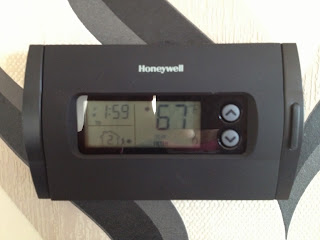Trim the Fat Tuesday: The Thermostat Adjustment
Week One of our New Year's resolution is here! The first step taken to save some cash in this project is pretty painless (I didn't even tell anyone I was doing it, and it's actually been this way for a month without anyone even noticing):
Lower the thermostat by 1 degree.
We already have a programmable thermostat, which we use to set the heat back by 8 degrees while we are gone during the day and 5 degrees while we are sleeping at night. I'm sure that also saves us money, but I have no idea how much, because we've always done that.
So that doesn't count — we're looking for new savings that I can actually count up and add to my mortgage payment.
A fairly quick internet search shows that the rule-of-thumb is that you can expect about 3% savings for every degree you turn down your thermostat. This is obviously affected by all kind of factors (house size, outside temperature, R-factor of your insulation, blah blah boring you can check out some charts from Michigan here if you're a science teacher or something), but we're going to stick with that number as a useful average. (If you're looking for some basic facts on why the thermostat setback is a good idea, read this short article from Mother Earth News.)
This means I have knocked back our heat to 67 degrees while we're home, 59 degrees while we're away, and 62 degrees while we're sleeping. Minus one degree across the board.
Last year we spent $1,990.36 on heating oil for the winter season. So far the price of oil is about the same this year, so I'm just going to calculate the savings using last year's numbers. 3% of that total is a savings of $59.71 for the season, or $4.98 per month over the course of a whole year.
Totally gonna round that up to $5 a month to add to our payment for early payoffs.
BORING TECHNICALITY NOTE: I think that my original idea about paying off the mortgage is solid, but that we're going to start with the car payment first instead. There's no tax advantage there, and it has a higher interest rate, but I kind of forgot about it. And after a few more calculations, it turns out that if we pay that off 2 1/2 years early with the extra $600 per month we hope to save, and then dump all the original car payment amount plus the extra payments onto the mortgage starting in 2015, we'll still have the mortgage paid off in 20 years. So this way we'll have two interest-charging loans out of the way in the same amount of time.
Seriously, the calculators are amazing when you start to run numbers and see the snowballing effects here. Totally motivating to keep that thermostat lower and reach for a sweater instead!
Savings per month: $5
Lower the thermostat by 1 degree.
We already have a programmable thermostat, which we use to set the heat back by 8 degrees while we are gone during the day and 5 degrees while we are sleeping at night. I'm sure that also saves us money, but I have no idea how much, because we've always done that.
So that doesn't count — we're looking for new savings that I can actually count up and add to my mortgage payment.
A fairly quick internet search shows that the rule-of-thumb is that you can expect about 3% savings for every degree you turn down your thermostat. This is obviously affected by all kind of factors (house size, outside temperature, R-factor of your insulation, blah blah boring you can check out some charts from Michigan here if you're a science teacher or something), but we're going to stick with that number as a useful average. (If you're looking for some basic facts on why the thermostat setback is a good idea, read this short article from Mother Earth News.)
This means I have knocked back our heat to 67 degrees while we're home, 59 degrees while we're away, and 62 degrees while we're sleeping. Minus one degree across the board.
Totally gonna round that up to $5 a month to add to our payment for early payoffs.
BORING TECHNICALITY NOTE: I think that my original idea about paying off the mortgage is solid, but that we're going to start with the car payment first instead. There's no tax advantage there, and it has a higher interest rate, but I kind of forgot about it. And after a few more calculations, it turns out that if we pay that off 2 1/2 years early with the extra $600 per month we hope to save, and then dump all the original car payment amount plus the extra payments onto the mortgage starting in 2015, we'll still have the mortgage paid off in 20 years. So this way we'll have two interest-charging loans out of the way in the same amount of time.
Seriously, the calculators are amazing when you start to run numbers and see the snowballing effects here. Totally motivating to keep that thermostat lower and reach for a sweater instead!
Savings per month: $5




Wow - you keep the house pretty chilly!
ReplyDeleteI think it's all relative--when it's only averaging 20 degrees outside, this seems pretty toasty. (And I actually just lowered it all by another degree because oil prices went up by another 20 cents a gallon on our latest delivery.) The only time we really feel the chill is when the temperatures drop below 10 degrees or so. Our house isn't insulated, so that's when you can feel the cold pressing in from the edges of the house. Insulation is very high on our list of house projects--it will practically pay for itself!
ReplyDelete